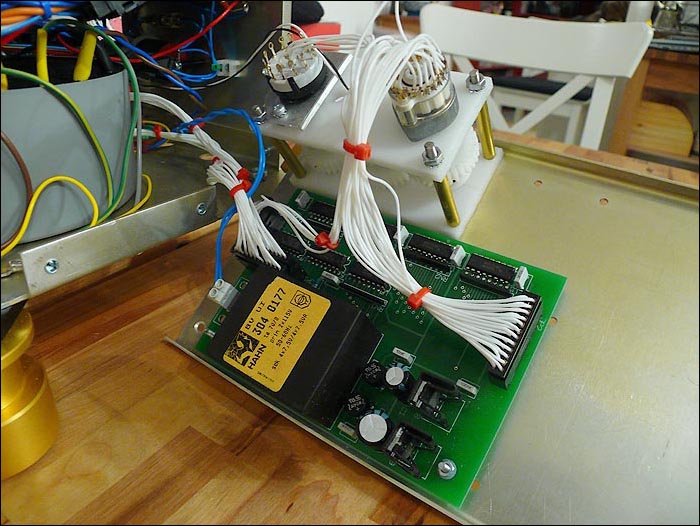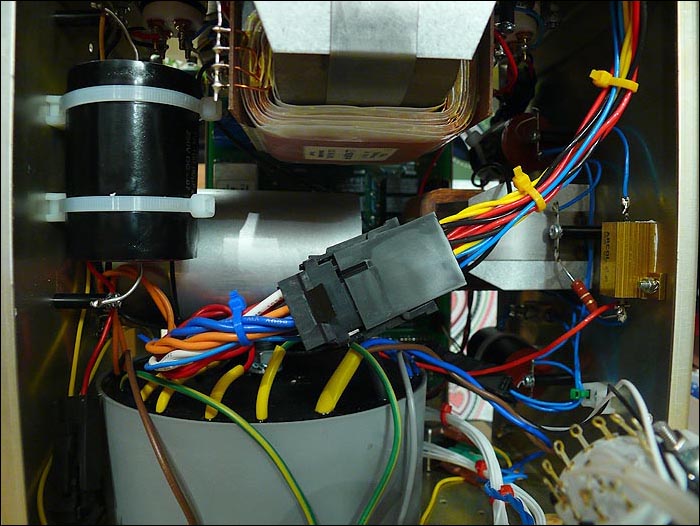|
|
|
|
|
This review page is supported in part by the sponsors whose ad banners are displayed below
|
|
 |
|
 |
|
|
The monos arrived in two sizeable self-paletted crates. Those cradled their single-layer inner ship cartons in 2"-thick brittle styrofoam slabs. The acrylic dress panels were wrapped in brown Kraft paper and stashed outside the carton. The tubes were packed as dedicated sets of seven and in separate boxes. Each individual tube was labeled with an arbitrary non-sequential number. That number corresponded to a small red paper dot affixed next to each tube socket. Simply remove the magnetically fixed, thin gold-anodized dress plate on top and take note of the assigned locations.
Removing that dress plate also shows how the round-cornered slip cover is affixed. Four slots in the corners of the wood cover receive a loose metal lip each which screws into the main metal carcass. Very simple, it's also mechanically too weak to lift up the top-heavy amp by the lower edges of the wood. Be sure your fingers grasp the actual metal base.
That base sports four magnetized stand-off pucks for the stylishly bent acrylic dress panels These panels work like an orange skin that's been quartered and peeled back to flower. To not fall outwards, the lower curved portions sit on the golden footers' recessed ledges. Small glued-in magnets then couple to the magnets on the base [lower right photo]. Structurally fragile, this assembly is for cosmetics only. The amps should not be moved that way since the acrylic panels will invariably bend inwards.
|
|
 |
|
|
 |
|
Unlike the £5990 Emillé Labs KM-300 SE's packaging with professionally molded inserts above, Engström still needs to improve his. He also must include at least one spare 300B, replacement fuses, gloves to install the acrylic dress pieces, a specialized metal polish to keep the gold trim bits immaculate and properly bind his owner's manual which at present are a few stapled sheets. The same befalls certain construction details. If your pricing goes all out, so must your attention to detail. The thin inset top cover is fixed to the metal core with glued-on magnetized washers to create metal-on-metal contacts that rattle when tapped. For ventilation purposes perhaps, this cover leaves an air space around it that's wide enough to see some of the industrial bolts that hold together the innards. Wavac or Zanden would not approve. |
|
 |
|
|
|
|
 |
|
The firmly bolted metal core is no-nonsense utilitarian and tough. It reminded me of a bomb shelter. Carefully removing the control unit's front panel then revealed not only the three-dimensionally wired-up innards with their big multi-pin connectors but also vertical circuit boards front and back and a massive but clunky cog-wheel assembly for the dual-concentric input/volume control.
|
|
|
 |
|
|
This image opens to a larger inside shot in a new window
|
|
|
|
Mounted to the same cogwheels panel was the circuit board for the relays.
|
|
 |
|
|
This image opens to a close-up of the circuit board in a new window
|
|
|
|
The next photo conveys the 3D internal assemblies. All the main hardware bits are naturally mounted to either the base, top or side panels. Those bits must be wired up to each other before the elongated metal cube with its lopped-off corners gets bolted together. Hence the absolute necessity for otherwise redundant multi-pin connectors and extra-long wire bundles. Devotees of ultra-short circuit paths won't be impressed at all. Of course the presence of an output transformer with its endless windings alone should have signalled a different religion from the very beginning.
|
|
 |
|
|
This image opens to a taller version of the same view in a new window
|
|
|
 |
 |
Back to cosmetics. Instead of engraved or silk-screened tube markers, theLars uses paper stickers. Very un-luxurious, two of the JJ 300Bs suffered loose sockets as has become typical for the brand.
|
|
| Where the $10,000 ModWright DM 36.5 sports a super-stout screw-lock umbilical of considerable girth, the Lars umbilical terminates in visually less-than-impressive plastic bits tie-wrapped to a sloppily cut-off jacket on a skinny lead. While it likely has zero bearings on sonics, it does rather tweak perception. Ditto for removing static-cling styro bits from the acrylic panels wrapped in brown Kraft paper. |
|
| The included Furutech cords were a nice touch again as were the white power LEDs, one in the center of the master control, the other on the slave unit. |
|
|
|
|
 |
|
Turning the main controls was reassuringly solid yet nearly as yeoman clunky as an old Harley clutch due to the cogwheel coupling. Most prospective buyers would prefer remote control and outright chuck the existing solution. The acrylic bits are naturally prone to scratches, dust and finger prints and will become regular maintenance candidates for Windex or similar treatments. I left them off.
|
|
 |
|
|
For a first sound check, I made the connections and fired up the master mains. The LEDs lit up, no mechanical or electrical hum -- not even with ears glued to cones, domes and transformers -- followed of any sort and soon there was music. That's where a free consultation finally turned proper audio review.
|
|
 |
|
|
To be improved
First, a wrap on what needs handling to begin competing in the luxury league. The umbilical (see above) and top cover need a rethink, the packaging proper engineering. Shoppers have a right to expect the best tubes money can buy, current production be damned. That's for plebs. So are paper stickers and stapled sheets. While painfully costly to manufacture, the current finish of the wooden slip cover doesn't look it. Why set a diamond if it don't sparkle? Once attended, I still don't believe the final package will anywhere near justify its current price amongst those with the expected experience to know that equivalent or superior performance is available for so much less.
|
|
 |
|
|
If you're engineering-driven to not believe that exotic-core output transformers with age-annealed silver wire are superior to a silicon-steel/copper variant (substitute your favorite cost-no-object parts), the entire luxo concept mostly becomes a put on, not true self expression. Unless -- and here Vladimir Lamm's reputation once again serves as example -- you manage performance from ordinary ingredients that's so outrageously superior as to make all else mute.
|
|
 |
|
|
 |
 |
|
|
 |
|
|
|
|
|
|
|
|
|
|
|
|